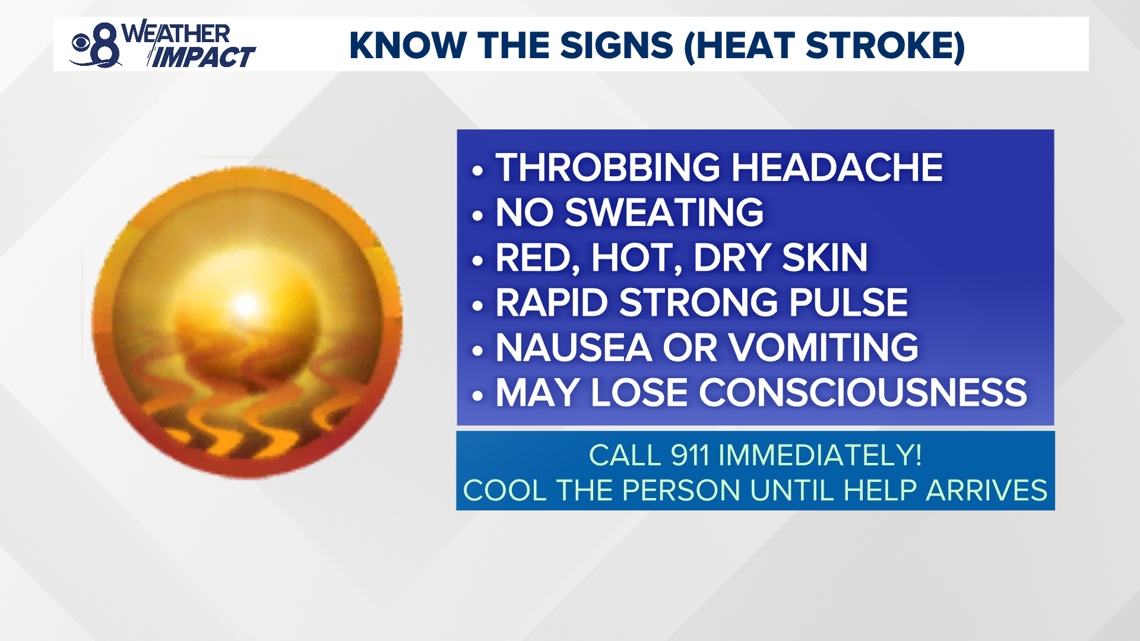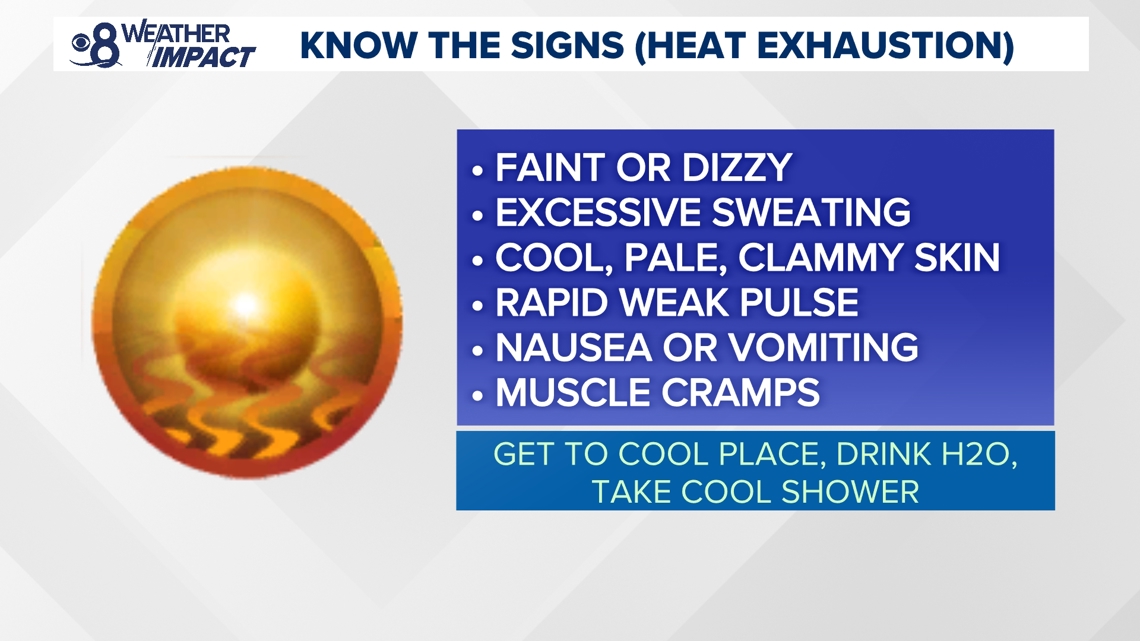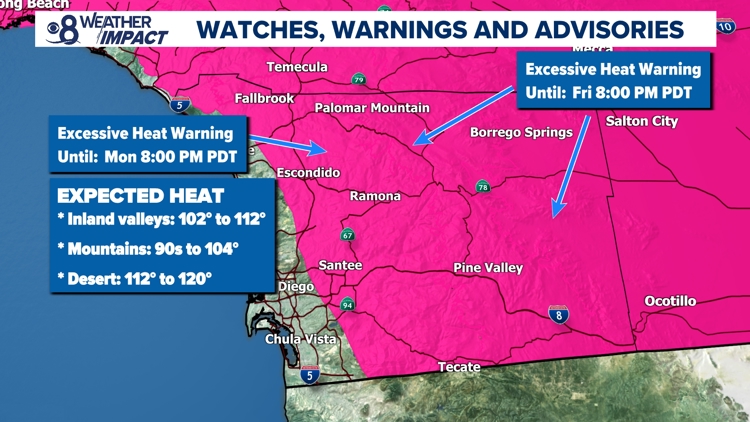SAN DIEGO — Dangerously hot temperatures will continue across San Diego County peaking between 10 and 20 degrees warmer than normal on Friday. While some were under the assumption that the start of September would coincide with the start of fall-like weather, current forecasts prove that wrong as summer remains in full swing all the way across the Southwestern United States.
The National Weather Service has issued an Excessive Heat Warning. This applies to San Diego County inland valleys, mountains and the desert. For the mountains and the desert, the alert will expire on Friday night. The National Weather Service has extended the excessive heat warning for the inland valleys to Saturday night. A Heat Advisory has also been issued for coastal and metro cities in San Diego County. It went into effect on Thursday morning and is extended to Friday night.
With temperatures reaching the triple digits in some areas of San Diego County, this article outlines ways to stay safe and cool in the heat.
WATCH: San Diego County braces with Excessive Heat Warning
Weather Impact | Watches, warnings, advisories
SDG&E wants customers to plan ahead now, and take steps to cool down their homes. This heat wave is expected to bring warm temperatures into the evening hours.
"Your electricity rate is different throughout different periods of the day. In the morning, it's different than a really expensive rate in the afternoon during 4:00-9:00, that's called peak pricing," said Anthony Wagner, Communications Manager for SDG&E.
- Ceiling and portable fans can help circulate air and reduce the need for air conditioning. Remember to turn them off when leaving room.
- Set the thermostat to 78°F when home and higher when away, if possible. Consider using a programmable thermostat to automate temperature adjustments.
- Keep blinds and curtains closed during the hottest parts of the day to block out direct sunlight and reduce indoor temperatures.
- Use a slow cooker, microwave or grill instead of ovens to help save energy and keep the home cooler. Also, use dishwashers and laundry machines outside of the on-peak hours of 4 p.m. to 9 p.m.
- Stay informed by adjusting energy or spending alerts to avoid surprises on your next bill.
- Use the Vampire Calculator: Find out what devices in your home that may be draining energy.
- First and foremost, if you find someone who is suffering from symptoms of heatstroke or heat exhaustion—dizziness, nausea, confusion, headache—call 9-1-1 and start cooling them. But DO NOT give them fluids to drink. A person with heatstroke may not be able to swallow. Fluids could run down their tracheas into their lungs and make it hard for them to breathe.
- After calling 9-1-1, start cooling the person by moving them into the shade, spraying them with cool water and fanning. Place them in a cool shower if they are alert, monitor their body temperatures and continue cooling them.




CBS 8 asked UC San Diego Emergency Physician Christanne Coffey what signs to look out for when it comes to heat exhaustion and heat stroke.
"Fatigue, maybe some nausea, probably not vomiting, yet, often a lot of sweating. Or feeling maybe a mild headache, just not feeling their normal kind of physical stamina they typically have. You want to notice that immediately and try to reverse them from getting more hot, because it can progress to heat stroke, and often with heat stroke in general, those symptoms kind of the definition is some type of neurologic change. So those people may be very confused. You may come upon, upon someone on the trail that's completely unconscious," said Dr. Coffey.
Dr. Coffey suggests finding shade for yourself or someone else in distress. If there's no shade around, consider using an article of clothing to make a shade structure. If water is available, douse yourself to cool down, and call 911.
- Stay in an air-conditioned area during the hottest hours of the day. Even a few hours spent in air conditioning can help your body stay cooler. Do not rely on electric fans for cooling if temperatures exceed 90 degrees.
- Wear light, loose-fitting clothing.
- Drink plenty of water (avoid alcohol and sugary drinks) and don’t wait until you are thirsty.
- Take cool showers.
- Never leave a child, elderly person, or pet unattended in a car.
- Keeping pets cool in hot weather.
- Avoid unnecessary hard work or activities outside during the hottest part of the day.
- Avoid unnecessary sun exposure and wear a wide-brim hat if you need to be in the sun.
- Avoid using the oven to cook.
- Keep your pets indoors if the temperature is lower inside.
- Exercise pets in the early morning hours or early evening to avoid prolonged exposure to the heat. Avoid strenuous runs or hikes.
- Keep your pets’ water supply in a tip-proof container, always topped off, and be sure it stays cool (pets will not drink water that is too hot).
- Consider a misting system to keep the outdoor areas cooler.
- Be sure your pet has shade ALL DAY if they are outside. Remember, the sun’s position changes during the day.
- Do not take your pets for car trips unless necessary. A car can heat up very quickly. On an 85-degree day, a car can reach 102 degrees in 10 minutes and soar upward even with the windows down an inch or two.
- Don’t take your dogs for walks on the hot pavement. If it is too hot for you to walk barefoot, then don’t make your dogs do it either.
- Consider adding a child’s wading pool for your dog. Many dogs will keep cool by “taking a dip.”
- Petco's across the county are animal cool zones where you're welcome to escape the heat in air conditioned stores. Their chief veterinarian said signs of overheating and dehydration can include panting, drooling, weakness, deep or rapid breathing, along with disorientation and vomiting.
Watch Related: Heat on the rise in San Diego County (Sep 3, 2024)





